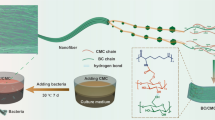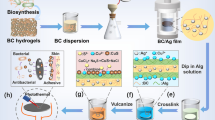Abstract
The formulation of an antibiotic-free antibacterial approach is imperative in circumventing escalating bacterial drug resistance. Electrical stimulation presents a viable therapeutic modality for such an approach. Nonetheless, obstacles persist in achieving efficacious sterilization with biosafe low-voltage electrical fields (EFs) and enduring antibacterial capabilities. In this study, we have devised a novel capacitive antibacterial dressing comprising polypyrrole-wrapped carbon cloth (PPy-CC) electrodes and a bacterial cellulose (BC) hydrogel separator. Subjected to 1 V electrical stimulation for 10 min, the dressing attains high bactericidal efficiency (up to 99.97%) and enhanced activity against multidrug-resistant (MDR) bacteria (up to 99.99%). Its considerable electric capacity and rechargeability allow for repeated charging to achieve sustained sterilization. In vivo results demonstrate significant inhibition of wound infection and facilitated wound recovery in infected full-thickness defects in mouse models. This represents an antibiotic-free, physically-stimulated treatment modality for infected wounds with considerable potential for clinical application.
TOC
A capacitive antibacterial dressing consists of polypyrrole-wrapped carbon cloth as electrode layer and bacterial cellulose hydrogel as separator with efficiently accelerated infected-wound healing. The resultant hydrogel dressing exhibits excellent high capacitance characteristics, good biocompatibility, efficient and sustained antibacterial ability after low voltage charging. It is an antibiotic-free, physical stimulation-based strategy for infected wounds.








Similar content being viewed by others
Availability of data and materials
All data and materials supporting the finding of this study are available within the paper and its supplementary information.
References
Zhou L, Zheng H, Liu Z, Wang S, Liu Z, Chen F, Zhang H, Kong J, Zhou F, Zhang Q (2021) ACS Nano 15:2468. https://doi.org/10.1021/acsnano.0c06287
He J, Shi M, Liang Y, Guo B (2020) Chem Eng J 394. https://doi.org/10.1016/j.cej.2020.124888
Liang Y, He J, Guo B (2021) ACS Nano 15:12687. https://doi.org/10.1021/acsnano.1c04206
Li Y, Fu R, Duan Z, Zhu C, Fan D (2022) Bioactive Materials 9:461. https://doi.org/10.1016/j.bioactmat.2021.07.023
Theuretzbacher U, Outterson K, Engel A, Karlén A (2020) Nat Rev Microbiol 18:275. https://doi.org/10.1038/s41579-019-0288-0
Hutchings MI, Truman AW, Wilkinson B (2019) Curr Opin Microbiol 51:72. https://doi.org/10.1016/j.mib.2019.10.008
Zhao Y, Guo Q, Dai X, Wei X, Yu Y, Chen X, Li C, Cao Z, Zhang X (2019) Adv Mater 31:1806024. https://doi.org/10.1002/adma.201806024
Chu J, Vila-Farres X, Inoyama D, Gallardo-Macias R, Jankowski M, Satish S, Freundlich JS, Brady SF (2018) Acs Infectious Diseases 4:33. https://doi.org/10.1021/acsinfecdis.7b00056
Chan BK, Sistrom M, Wertz JE, Kortright KE, Narayan D, Turner PE (2016) Sci Rep 6. https://doi.org/10.1038/srep26717
Shi R, Zhang J, Tian J, Zhao C, Li Z, Zhang Y, Li Y, Wu C, Tian W, Li Z (2020) Nano Energy 77:105201. https://doi.org/10.1016/j.nanoen.2020.105201
Tao Y, Ju E, Ren J, Qu X (2015) Adv Mater 27:1097. https://doi.org/10.1002/adma.201405105
Tang S, Zheng J (2018) Adv Healthc Mater 7. https://doi.org/10.1002/adhm.201701503
Principi N, Silvestri E, Esposito S (2019) Front Pharmacol 10. https://doi.org/10.3389/fphar.2019.00513
Qi X, Huang Y, You S, Xiang Y, Cai E, Mao R, Pan W, Tong X, Dong W, Ye F, Shen J (2022) Adv Sci 9. https://doi.org/10.1002/advs.202106015
Tian J, Feng H, Yan L, Yu M, Ouyang H, Li H, Jiang W, Jin Y, Zhu G, Li Z, Wang ZL (2017) Nano Energy 36:241. https://doi.org/10.1016/j.nanoen.2017.04.030
Wang G, Feng H, Hu L, Jin W, Hao Q, Gao A, Peng X, Li W, Wong K-Y, Wang H, Li Z, Chu PK (2018) Nat Commun 9:2055. https://doi.org/10.1038/s41467-018-04317-2
Li C, Li Z, Zeng Y, Cao X, Zhao H, Yang YY, Yuan P, Lu X, Ding X (2022) Adv Healthcare Mater 11:2102044. https://doi.org/10.1002/adhm.202102044
Duncan B, Li X, Landis RF, Kim ST, Gupta A, Wang L-S, Ramanathan R, Tang R, Boerth JA, Rotello VM (2015) ACS Nano 9:7775. https://doi.org/10.1021/acsnano.5b01696
Balint R, Cassidy NJ, Cartmell SH (2014) Acta Biomater 10:2341. https://doi.org/10.1016/j.actbio.2014.02.015
Thakur AV, Pathan HM, Lokh BJ, e. e. (2022) ES Energy Environ 18:75. https://doi.org/10.30919/esee8c751
Liang Y, Wei Z, Zhang X, Wang R (2022) ES Energy Environ 18:101. https://doi.org/10.30919/esee8c783
Wang J, Tavakoli J, Tang Y (2019) Carbohyd Polym 219:63. https://doi.org/10.1016/j.carbpol.2019.05.008
Boni BOO, Lamboni L, Bakadia BM, Hussein SA, Yang G (2020) Eng Sci 10:68. https://doi.org/10.30919/es8d906
Boni BOO, Lamboni L, Mao L, Bakadia BM, Shi Z, Yang G (2022) Eng Sci 19:175. https://doi.org/10.30919/es8d700
Lin W-C, Lien C-C, Yeh H-J, Yu C-M, Hsu S-H (2013) Carbohyd Polym 94:603. https://doi.org/10.1016/j.carbpol.2013.01.076
Xie Y-Y, Hu X-H, Zhang Y-W, Wahid F, Chu L-Q, Jia S-R, Zhong C (2020) Carbohydr Polym 229. https://doi.org/10.1016/j.carbpol.2019.115456
Nautiyal A, Qiao M, Cook JE, Zhang X, Huang T-S (2018) Appl Surf Sci 427:922. https://doi.org/10.1016/j.apsusc.2017.08.093
Jasim A, Ullah MW, Shi Z, Lin X, Yang G (2017) Carbohyd Polym 163:62. https://doi.org/10.1016/j.carbpol.2017.01.056
Zheng R-Z, Shi Z-J, Yang G (2020) Acta Polymerica Sinica 51:942. https://doi.org/10.11777/j.issn1000-3304.2020.20110
Malinauskas A (2001) Polymer 42:3957. https://doi.org/10.1016/s0032-3861(00)00800-4
Snook GA, Kao P, Best AS (2011) J Power Sources 196:1. https://doi.org/10.1016/j.jpowsour.2010.06.084
Chen X, Yuan F, Zhang H, Huang Y, Yang J, Sun D (2016) J Mater Sci 51:5573. https://doi.org/10.1007/s10853-016-9899-2
Bedre MD, Basavaraja S, Deshpande R, Balaji DS, Venkataraman A (2010) International Journal of Polymeric Materials and Polymeric. Biomaterials 59:531. https://doi.org/10.1080/00914031003760642
Ge H, Qi G, Kang E-T, Neoh KG (1994) Polymer 35:504. https://doi.org/10.1016/0032-3861(94)90503-7
Lu K-H, Sheen Y-J, Huang T-P, Kao S-H, Cheng C-L, Hwang C-A, Sheen S, Huang L, Sheen L-Y (2020) Food Microbiol 89:103374. https://doi.org/10.1016/j.fm.2019.103374
Wu J, Zheng Y, Song W, Luan J, Wen X, Wu Z, Chen X, Wang Q, Guo S (2014) Carbohyd Polym 102:762. https://doi.org/10.1016/j.carbpol.2013.10.093
Wu C, Shen L, Lu Y, Hu C, Liang Z, Long L, Ning N, Chen J, Guo Y, Yang Z, Hu X, Zhang J, Wang Y (2021) ACS Appl Mater Interfaces 13:52308. https://doi.org/10.1021/acsami.1c14088
Lin T-Y, Weibel DB (2016) Appl Microbiol Biotechnol 100:4255. https://doi.org/10.1007/s00253-016-7468-x
Ashrafi M, Baguneid M, Alonso-Rasgado T, Rautemaa-Richardson R, Bayat A (2017) Future Microbiol 12:337. https://doi.org/10.2217/fmb-2016-0204
Lai S, Wang Y, Wan Y, Ma H, Fang L, Su J (2022) ACS Appl Mater Interfaces 14:20139. https://doi.org/10.1021/acsami.2c04359
Bainbridge P (2013) J Wound Care 22:407. https://doi.org/10.12968/jowc.2013.22.8.407
Talikowska M, Fu X, Lisak G (2019) Biosens Bioelectron 135:50. https://doi.org/10.1016/j.bios.2019.04.001
Khaw JS, Xue R, Cassidy NJ, Cartmell SH (2022) Acta Biomaterialia 139:204. https://doi.org/10.1016/j.actbio.2021.08.010
Mao L, Hu S, Gao Y, Wang L, Zhao W, Fu L, Cheng H, Xia L, Xie S, Ye W, Shi Z, Yang G (2020) Adv Healthc Mater 9
Wang L, Mao L, Qi F, Li X, Ullah MW, Zhao M, Shi Z, Yang G (2021) Chem Eng J 424
Luo R, Dai J, Zhang J, Li Z (2021) Adv Healthc Mater 10. https://doi.org/10.1002/adhm.202100557
Versey Z, da Cruz Nizer WS, Russell E, Zigic S, DeZeeuw KG, Marek JE, Overhage J, Cassol E (2021) Front Immunol 12. https://doi.org/10.3389/fimmu.2021.648554
Atamas SP (2002) Life Sci 72:631. https://doi.org/10.1016/s0024-3205(02)02299-3
Abedin-Do A, Zhang Z, Douville Y, Methot M, Bernatchez J, Rouabhia M (2022) J Tissue Eng Regen Med 16:643. https://doi.org/10.1002/term.3305
Veith AP, Henderson K, Spencer A, Sligar AD, Baker AB (2019) Adv Drug Deliv Rev 146:97. https://doi.org/10.1016/j.addr.2018.09.010
Li C, Zhang S, Yao Y, Wang Y, Xiao C, Yang B, Huang J, Li W, Ning C, Zhai J, Yu P, Wang Y (2023) Adv Healthc Mater. https://doi.org/10.1002/adhm.202300064
Acknowledgements
The author also was grateful for the Analytical and Testing Centre of Huazhong University of Science and Technology (HUST) and the test platform of Life Sciences College at HUST for characterization of samples.
Funding
This work was supported by the National Natural Science Foundation of China (Grant No.51973076).
Author information
Authors and Affiliations
Contributions
Hao Wang, Zhijun Shi, Guang Yang conceived this research and designed experiments. Hao Wang, Ruizhu Zheng, Pengyu He and Xiaoming Li performed experiments, analysis, and interpretation of the data. All authors participated in the interpretation of the data. Hao Wang and Zhijun Shi wrote the paper and participated in the revision of it. All authors read, revised, and approved the final manuscript.
Corresponding authors
Ethics declarations
Conflicts of interest
The authors declare that they have no conflict of interest.
Additional information
Publisher's Note
Springer Nature remains neutral with regard to jurisdictional claims in published maps and institutional affiliations.
Supplementary Information
Below is the link to the electronic supplementary material.
Rights and permissions
Springer Nature or its licensor (e.g. a society or other partner) holds exclusive rights to this article under a publishing agreement with the author(s) or other rightsholder(s); author self-archiving of the accepted manuscript version of this article is solely governed by the terms of such publishing agreement and applicable law.
About this article
Cite this article
Wang, H., Zheng, R., He, P. et al. A capacitive polypyrrole-wrapped carbon cloth/bacterial cellulose antibacterial dressing with electrical stimulation for infected wound healing. Adv Compos Hybrid Mater 7, 10 (2024). https://doi.org/10.1007/s42114-023-00814-1
Received:
Revised:
Accepted:
Published:
DOI: https://doi.org/10.1007/s42114-023-00814-1




